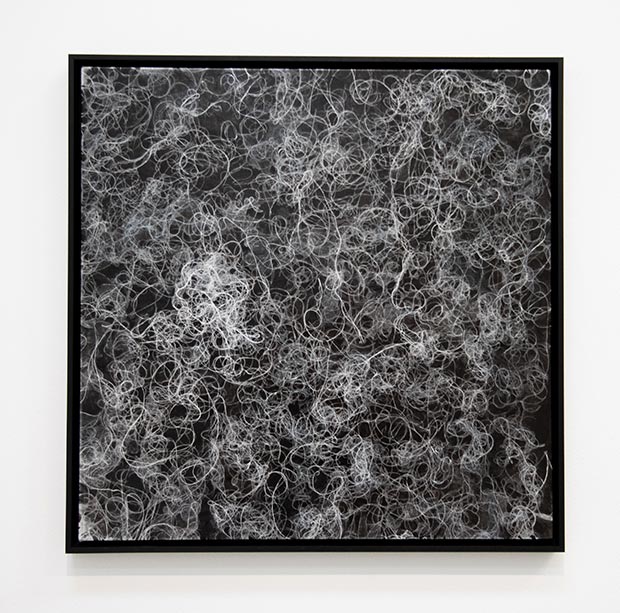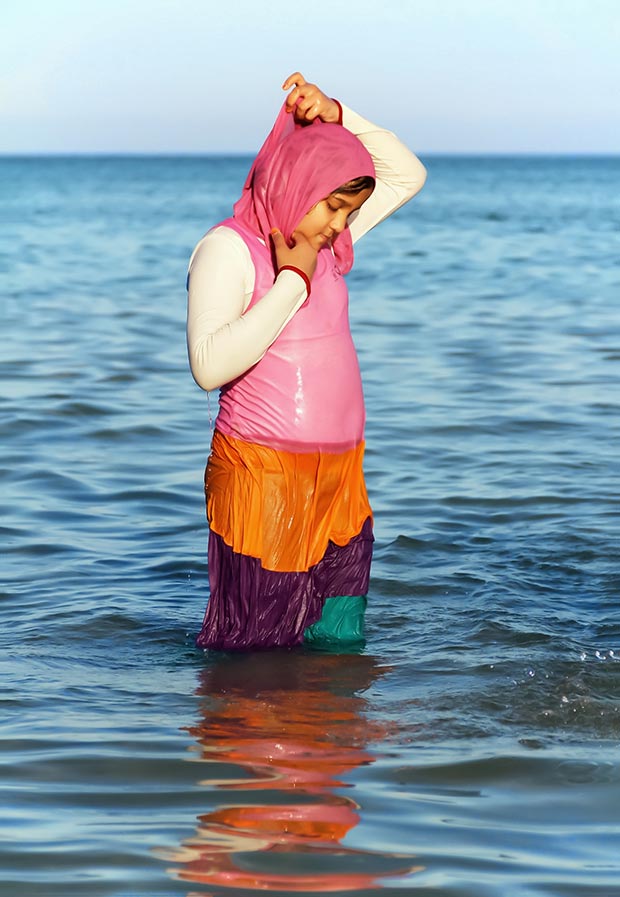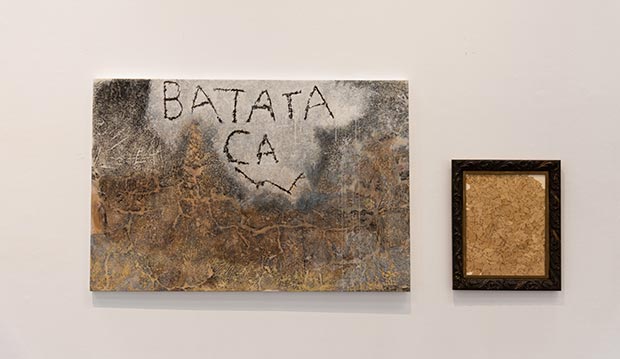
SOLO SHOW AT LAWRIE SHABIBI, DUBAI Nadia Kaabi-Linke: ‘Impossible Ordinary’
Nov 11, 2018 Exhibition
Kaabi-Linke is a Berlin-based Tunisian/Ukrainian artist whose practice is intertwined with socio-psychological topics: perception, memory, and geographically and politically constructed identities. Her work relates to places, spaces and surfaces – how the human presence shapes, has shaped and continues to shape their associations, moving between cities that include Berlin, Tunis, Paris, Dubai, and Kiev.
Basing this new group of work mainly on her experiences in Germany and in Tunisia, the title references the changes in contemporary life that seem at first unbelievable, and yet soon gain tacit acceptance. Amongst these moments of inspiration are her son’s childhood paintings, the image of a Tunisian girl at the beach, a discreetly repaired bullet-ridden wall in Berlin and a wall in Tunis bearing covert political inscriptions. In the process, Kaabi-Linke experiments with a wide array of everyday materials: peeled potato skin, liquid paper ('Tipp Ex'), manicure instruments, terracotta tiles, and coloured pencils, using these familiar objects to explore the construction of the “new normalâ€.
Several of Kaabi-Linke’s past works have used her hair or prints derived from it - female hair carrying a host of associations and ascription such as time, age, desire, beauty and elegance - altogether summed up in a rather masculine idea of femininity. On the other hand, 'Negative of Black Hair on White Ground', a printed monotype with acrylic uses hair in an abstract painting showing nothing but white-washed imprints of hair neutralised by any kind of narrative while formally referencing the black square of Malevich that was breaking the need for representation.
 Nadia Kaabi-Linke. Negative of Black Hair on White Ground. 2018. Etching ink on paper on canvas. 79.5 x 79.5 cm / Photography by Amir Dakkak. Courtesy Lawrie Shabibi and the artist
Nadia Kaabi-Linke. Negative of Black Hair on White Ground. 2018. Etching ink on paper on canvas. 79.5 x 79.5 cm / Photography by Amir Dakkak. Courtesy Lawrie Shabibi and the artist
“Pale Geranium Lake and Scarlet (remastered)†is another investigation into abstract picture-making. Here Kaabi-Linke has inflated her three-year-old son’s pen and coloured-pencil drawing on an A4 sheet of paper into monumental size, using the same colours as her son before laying onto canvas. In reality a magnified child’s drawing, it was faithfully reproduced according to Kaabi-Linke’s conceptual print-based strategy that unfolds the small hand drawing step by step into a large scale miniature whose reduced colour profile and calligraphic momentum shares qualities with the highly elaborate formal language of Abstract Expressionism. For Kaabi-Linke this work is about the idea of an impossible painting: impossible in its very proportions, technique and logic.
Kaabi-Linke explores shifting attitudes in “Mistake-Out Friedrichstadtâ€, a wall-based installation of over 400 parts taken from a repaired wall around a window on the first floor of a Berlin street in its newspaper publishing district, once riddled with bullet holes. Kaabi-Linke covers hundreds of pieces of card with liquid paper ('Tipp Ex') to create a subtle white on white mosaic on the gallery wallin the same configuration as the bullet marks which despite their cosmetic repairs still remain visible. The installation is a critique on the matter of censorship and auto-censorship that goes hand in hand with the repression of disquieting memories in such a way that it goes on almost unnoticed, as we get used to the experience of being monitored in our everyday life while the news we receive is edited and chosen for us.
Meanwhile, the photograph 'Sidi Ali El Makki, 2011', shows a six-year-old Tunisian girl in a headscarf looking into the water. In pre-revolution Tunisia such a sight would be a rarity - girls this young were forbidden to wear the scarf. Since 2011 this has become a regular occurrence.
 Nadia Kaabi-Linke. Sidi Ali El Makki, 2011. 2018. Archival photo print on Hahnemühle fine art paper, dibond and acrylic. 53 x 36.5 cm / Courtesy Lawrie Shabibi and the artist
Nadia Kaabi-Linke. Sidi Ali El Makki, 2011. 2018. Archival photo print on Hahnemühle fine art paper, dibond and acrylic. 53 x 36.5 cm / Courtesy Lawrie Shabibi and the artist
Connecting present day events with the past, 'Scorched Earth' is a floor sculpture made of stoneware slabs water cut using a computer-controlled procedure, in which Kaabi-Linke follows the course of the soil and weed-filled cracks between cobblestones on the Neumarkt in Dresden. It is the site where corpses were gathered the day after the firestorms devastated the city in February 1945. Twenty thousand were killed during two nights of raids by British and American bombers, one of the most controversial attacks by Allied forces in World War II. Today far-right groups congregate weekly at this place in what could be seen as a symptom of an unprocessed past that still haunts modern Germany.
Finally, a work that was a decade in the making, a dyptich formed from a print taken from a wall in Tunis in 2008, paired with a collage made from dried potato skins. The wall print carries the inscription 'BATATA', the nickname of a man who refused military service and was imprisoned by the military police under president Ben Ali’s regime, becoming a local hero. The nickname means 'potato' and is a reference to a poor man’s food – the protagonist hailing from a poor working class background. The second part of the work (the collage of dried potato skins) is exhibited in a frame that used to house a portrait of Ben Ali from the University of Agriculture: objects can be given new meaning in a different context. In this case: leaders disappear, the people remain.
 A dyptich by Nadia Kaabi-Linke. Photography by Amir Dakkak / Courtesy Lawrie Shabibi and the artist
A dyptich by Nadia Kaabi-Linke. Photography by Amir Dakkak / Courtesy Lawrie Shabibi and the artist
Kaabi-Linke studied at the Academy of Fine Arts in Tunis, and later at the Sorbonne University in Paris. Her installations and objects, as well as her pictorial works, are anchored in constellations of cultural and historical, social and political contexts and refer to a certain place or to coincidental events. Her works are part of several public and private collections including the Solomon R. Guggenheim , NYC, NY, USA; Centre Pompidou, Paris, France; The Museum of Modern Art (MoMA), NYC, NY, USA; Dallas Museum of Art, Dallas, TX, USA; M+ Museum, Hong Kong; Sharjah Art Foundation, Sharjah, UAE; Samdani Art Foundation, Dhaka, Bangladesh; Burger Collection, Hong Kong; Abraaj Group Art Collection, Dubai, UAE; Fondation Villa Datris pour la Sculpture Contemporaine, l’Isle-sur-La-Sorgue, France; Barjeel Art Foundation, Sharjah, UAE; ARTER VehbiKoç Foundation, Istanbul, Turkey; JP Morgan Chase Art Collection, New York, NY, USA; The Ramzi and SaedaDalloul Art Foundation, Lebanon; Kamel Lazaar Collection, Tunis, Tunisia and Ministère de la Culture et de la Sauvegarde du Patrimoine, Tunis, Tunisia. She has received a number of awards including:the New Discoveries Prize at Art Basel Hong Kong (2014), the Abraaj Capital Art Prize, Dubai, UAE (2011), First prize in UmbauStadt art and Urban Architecture Competition, Berlin, Germany (2010), and the Jury Prize at the Alexandria Biennale (2009). Kaabi-Linke currently lives and works in Berlin.
Comments
Add a comment